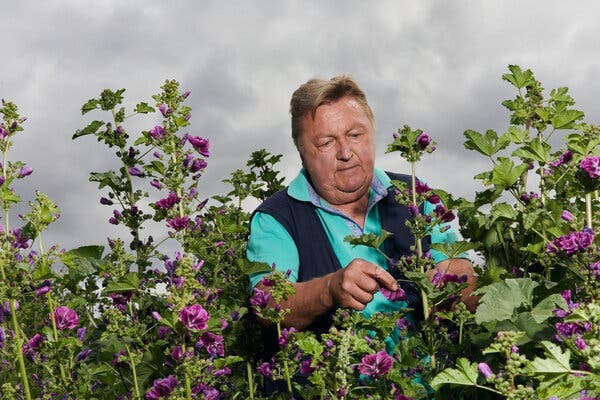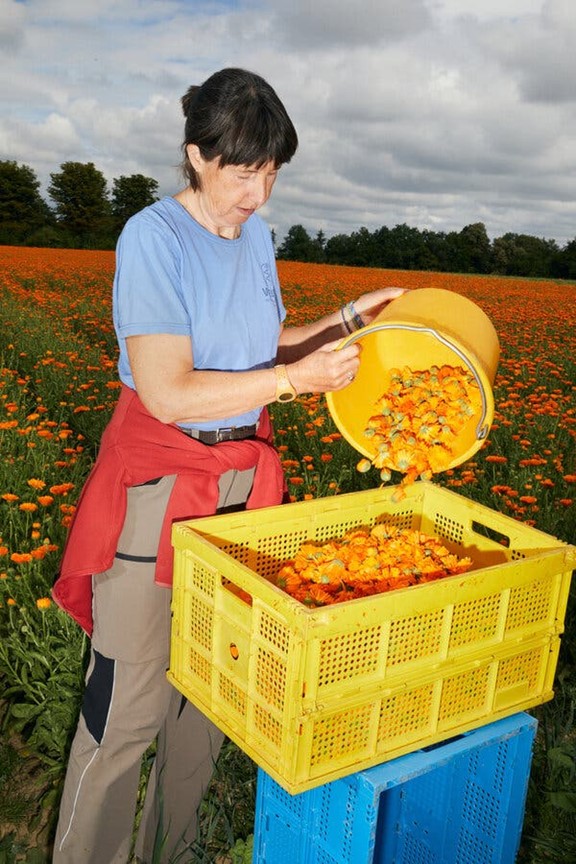

Weleda's Ties to Steiner
A long-time favorite in our school community and sold in our school store, Weleda products are on the cutting edge of regenerative farming and social responsibility, as well as being popular in the celebrity crowd. Here's a little history of the products, the mission of the company and its ties to Rudolf Steiner, founder of Waldorf education.
Originally posted in full by Chantel Tattoli in the New York Times on August 20, 2022
Calendulas look like daisies, smell like marigolds and possess powerful phytochemicals that can mend skin. At a garden in Schwäbisch Gmünd, Germany, Astrid Sprenger’s blond bob and turquoise pendant swung in the sun as she picked the fiery orange flowers by hand.
“It’s one of the only plants you can put on open wounds,” she said.
Dr. Sprenger, 56, who holds a Ph.D. in agricultural science from the University of Hohenheim in Stuttgart, is a head gardener at Weleda, a Swiss company perhaps best known for its ultrarich Skin Food cream. Sold in parrot green tubes, the moisturizer costs $12.49 an ounce.
Though Skin Food has gone by that name only since around 2010, its formula dates to 1926. In addition to extracts of calendula, it also contains concentrated forms of chamomile and wild pansy, as well as sunflower seed and sweet almond oils and beeswax.
The Skin Food line has expanded to include Skin Food Light, a less dense version of the original cream, along with a lotion and body and lip butters. According to Swati Gupta, Weleda’s head of e-commerce in North America, in 2020, the company sold a Skin Food product every five seconds. Weleda is developing new Skin Food cosmetics, including some for the face, with plans to debut them next year.
Farm to Tube
The plants used to make Skin Food and Weleda’s other products are grown worldwide. In Schwäbisch Gmünd, the 50-acre plot that Dr. Sprenger oversees runs wild-ish with some 260 species that include stonecrop and mistletoe. It is one of eight gardens owned by the company, which is based in Arlesheim, Switzerland, and sources from an additional 50 partner growers.
Occupying some 60,000 total acres, the web of gardens, which spans five continents, is roughly 70 times the size of Central Park.


Last year, Weleda achieved B Corp certification, meaning its operations meet certain social and environmental criteria. It is also certified by the Union for Ethical BioTrade, which sets best practices for sourcing ingredients.
The gardens it owns are certified by Demeter, an organization that maintains the standards for the agricultural practice known as biodynamic farming, which Dr. Sprenger compared to regenerative farming — an organic method that focuses on soil health and forgoes elements of industrialized agriculture such as synthetic chemicals — but “on a higher level.”
The practice demands strict standards for biodiversity and soil fertility; at Weleda’s gardens, topsoil is not tilled and crops are both rotated and intercropped, or grown together in the same plot, with three to 10 other species. Another tenet of biodynamic farming is composting. “It’s not like poo,” Dr. Sprenger said as she plunged a trowel into a dark mound that disgorged bugs and a heady herbal odor. “It’s nice!”
The compost she was sifting through contained homeopathic additives, or preparations, made from fermented plants including yarrow and valerian. Preparations are also a requirement of biodynamic farming, and others are sprayed directly onto soil or crops. One, called horn manure, does include excrement. It is made by packing cow dung into cow horns that are buried underground for the winter and dug up in the spring; the dung is then extracted from the horns, swirled into rainwater at body temperature and flicked at the soil with a brush, not unlike how a priest sprinkles holy water.

Some growers see preparations as magic potions of sorts, claiming they sensitize soil to cosmic rhythms. Followers of what’s known as the biodynamic calendar sow, plant and reap crops based on the positions of the sun, moon, planets and stars. (While not necessary for Demeter certification, some of Weleda’s gardens operate this way, but not the one in Schwäbisch Gmünd.)
More demonstrable benefits of the preparations, Dr. Sprenger said, include fungus control, increased microbial diversity, nitrogen stabilization and the ability for soil to sequester larger amounts of carbon.
Calendulas grown in Schwäbisch Gmünd are used to produce Weleda’s Comforting Cream Bath cleanser for babies. “In high season, we encourage our office employees to help with the harvest,” Dr. Sprenger said.
Those used in its Skin Food products are farmed biodynamically near Frankfurt and transported to a lab in Schwäbisch Gmünd, just five minutes by foot from the garden, where they are heated in sunflower-seed oil at around 155 degrees Fahrenheit, cooled and pressed into a concentrate that is then incorporated into various formulas.

Steady Growth
Weleda’s first gardens, in Switzerland and Germany, were in operation at the time it was formed in 1921 by Ita Wegman, a physician, and Rudolf Steiner, a New Age philosopher who two years earlier opened the first Waldorf, or Steiner, school. Then known as Futurum AG, it has since inception produced pharmaceutical as well as cosmetic products (only the cosmetics are sold in the United States).
Both the company and the school were influenced by the spiritual science movement anthroposophy. Also founded by Steiner, its adherents believe that everything in nature is interconnected. Before he died in 1925, Steiner gave a series of lectures on alternative agricultural techniques, which laid the groundwork for what later became known as biodynamic farming, said Peter Staudenmaier, an associate professor of history at Marquette University in Milwaukee.
Steiner and his followers wanted “to heal the earth,” said Dr. Staudenmaier, who specializes in the political history of environmentalism. “Their mission was to regenerate the soils that had been abused and despoiled by industrial processes,” he added.
Steiner’s thinking about agriculture continues to inform that of the company he co-founded, which in 1928 was renamed Weleda in a nod to Veleda, a Germanic priestess and healer who lived during the first century A.D.
“One of the most important things that we as a society can do to combat the effects of climate change is more regenerative agriculture,” Rob Keen, the chief executive of Weleda in North America, said.
“Select Steiner teachings are not reflective of Weleda’s guiding principles upon which we were founded more than 100 years ago and by which we continue to be guided today,” he added.

By 1931, five years after it introduced what would one day be called Skin Food, Weleda had opened an arm in the United States. Ahead of and during World War II, the company conducted business with the Nazi Party in Germany. It later made an effort to reconcile with this period in its history by issuing an apology to Holocaust survivors and opening its archives for academic research. Dr. Staudenmaier explored the Nazis’ connections to Weleda and other biodynamic growers in a 2013 research article. “Like any historian, I do wish that a company like Weleda would pay more attention to the complexities in its own history,” he said.
Domestically, its products were mainly sold at independent pharmacies and health food stores until 1984, when the grocer Whole Foods began to stock them.
According to Ameena Meer, who formerly worked as a creative director for Weleda in North America, Skin Food started to become more widely popular in 2017, around the time that consumers began to seek products that promised “dewy, glowy, glassy, glazed” complexions. The next year, Ms. Meer developed a marketing campaign to modernize Weleda in the United States, where she said it had a reputation as being old-fashioned.
Both the campaign and the renewed interest in Skin Food helped to usher in a “cool comeback” for Weleda, said Ms. Meer, 59, who lives in Los Angeles and now works as a wellness consultant and psychic. Major retailers that currently sell its products include Amazon, Target and, as of last year, Walgreens and CVS.
Food for Thought
“It’s thick,” Morgan Jerkins, a writer in New York, said of Skin Food.
“I feel like if I wear Weleda Skin Food, I’m going to be OK if I walk to the subway in February. I feel like it’s going to put up a fight.” Since she started using the product, Ms. Jerkins, 30, added that she has not had a need for foundation.
Skin Food also has fans in celebrities such as Gwyneth Paltrow and Sharon Stone. “I always have it in my set bag,” said Fiona Stiles, a makeup artist in Los Angeles who works with famous clients. “It’s so humectant!”
Ms. Stiles, 51, has carried the cream in her kit for 15 years. She particularly likes to use Skin Food as a topper, applying it with her palms onto the apples of clients’ cheeks for “a very even highlight.”
The product smells citrusy and, vaguely, of vanilla and bell pepper. “I imagine that people who love Campari, Ricola cough drops and the fragrance Bistro Waters, by the perfumer D.S. & Durga, tend to gravitate toward its scent,” said Porochista Khakpour, a writer in Los Angeles. Ms. Khakpour, 44, first discovered Skin Food more than a decade ago, in Berlin. “It’s deservedly iconic,” she added. “If someone is carrying it, I think they’re in the know.”
This year, Weleda promoted the Skin Food product line as part of a campaign to raise awareness of its agricultural practices. Called Save Earth’s Skin, it features the model Arizona Muse, 33, as its face. Ms. Muse, who lives in Ibiza, is also the founder of Dirt, an organization that funds biodynamic farming projects.
As a child, Ms. Muse attended Waldorf schools in Santa Fe, N.M., and Tucson, Ariz. She credits her interest in agriculture to her mother, who introduced her to Steiner’s anthroposophy movement, from which biodynamic farming was born.
“This is such a deeply protective approach,” Ms. Muse said of the method.
In the Save Earth’s Skin campaign, she compares soil to human skin, encouraging a twist on the golden rule: Do unto the planet’s dirt as you would your own epidermis.
